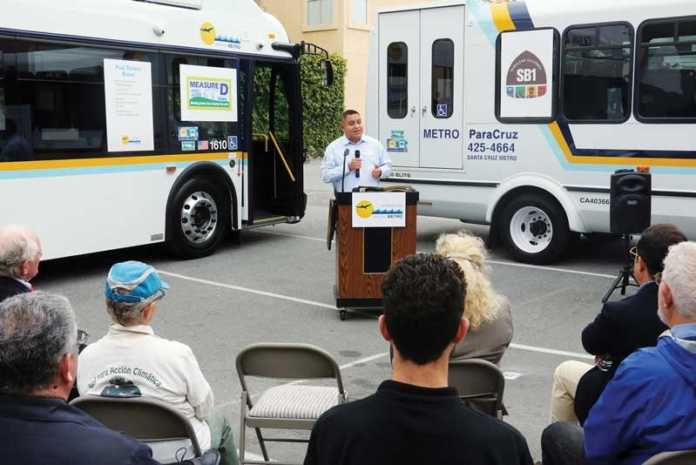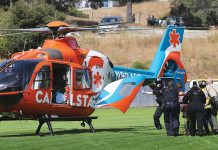(Santa Cruz METRO bus operator Eduardo Montesino addresses a crowd Thursday morning at a kickoff ceremony for a new fleet of buses and vans. Photo by Tarmo Hannula/Pajaronian)
SANTA CRUZ — A fleet of new Santa Cruz METRO buses and vans got a grand send off Thursday at a ceremony at the downtown Santa Cruz METRO Station.
With a handful of dignitaries present, 18 new vehicles that will be more efficient and run cleaner were set forth to replace aging vehicles.
“To make progress toward our greenhouse gas reduction goals and ensure reliable service for riders, replacement of older buses is a top priority,” said Bruce McPherson, chair of the METRO Board. “These new vehicles would not be possible without funding from Measure D and SB 1.”
Measure D, a one-half cent, 30-year transportation sales tax passed in November 2016, allows for METRO to receive $3 million annually.
SB 1, the road repair accountability act of 2017, generates about $5 billion statewide annually for ongoing and new transportation improvements. SB 1 provides METRO with approximately $3 million for operating and infrastructure support.
“Transportation is what people call us about more than anything else,” McPherson said. “The value of transportation can’t be overstated.”
METRO bus operator and former Watsonville mayor Eduardo Montesino told the gathering of the importance of the addition of the new fleet that will affect some routes to Watsonville. He said the buses will enhance METRO’s service to seniors getting to the market and a wide range of students who take the bus to school.
“I encourage people in Santa Cruz to keep moving forward,” he said.
The new fleet includes:
• Three new Paul Revere buses with a capacity of 40 seats and 20 standing (60 total capacity) per bus. Life expectancy is 12 years or 500,000 miles. Each bus costs $517,750 on a seven-year lease to buy program.
• Three new ParaCruz “Cut-Away” buses that can hold seven mobility devices or 22 ambulatory riders. Life expectancy is five years or 150,000 miles. The cost is $132,205 each.
• Twelve new vans at a cost of $75,000 each. Their capacity is three mobility devices or one mobility device plus nine ambulatory riders. Life expectancy is five years or 150,000 miles.












